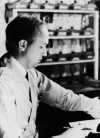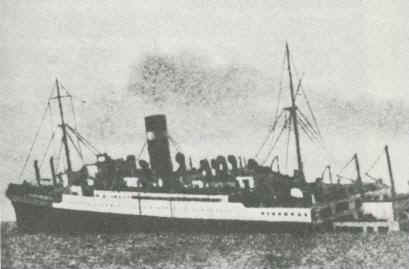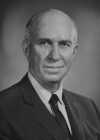The History of Nuclear Medicine
The Beginning of Radiopharmaceutical
Treatments
It was Ernest Laurence's brother, John, who realised the implication of the
cyclotron for medicine. John Lawrence had becom e a medical doctor after
studying at the University of South Dakota and Harvard. John Lawrence was
interested in the application of radioisotopes for the treatment of
cancer. John proposed that an intravenous or intramuscular injection of
radioactive sodium chloride around the site of the tumour could selectively
attack the cancer.
e a medical doctor after
studying at the University of South Dakota and Harvard. John Lawrence was
interested in the application of radioisotopes for the treatment of
cancer. John proposed that an intravenous or intramuscular injection of
radioactive sodium chloride around the site of the tumour could selectively
attack the cancer.
In 1935, John Lawrence went to Berkeley and started his research by
injecting some mice with leukemia  with radioactive phosphorus generated by the
cyclotron. He returned a few hours later after some fishing to find that
the mice's condition had improved. Lawrence was also concerned about the
health risks of his colleagues being exposed to large amounts of radiation. He,
therefore, put a rat inside the cyclotron near a beryllium sample being
bombarded with alpha particles. Ernest was told to expose the rat for
about a minute at a low dose and then turn the cyclotron off. John came
back after a few hours to find that the rat was dead. This scared everyone
and so the shielding around the cyclotron was increased but later it was determined
that the rat died of suffocation much to everyone's relief.
with radioactive phosphorus generated by the
cyclotron. He returned a few hours later after some fishing to find that
the mice's condition had improved. Lawrence was also concerned about the
health risks of his colleagues being exposed to large amounts of radiation. He,
therefore, put a rat inside the cyclotron near a beryllium sample being
bombarded with alpha particles. Ernest was told to expose the rat for
about a minute at a low dose and then turn the cyclotron off. John came
back after a few hours to find that the rat was dead. This scared everyone
and so the shielding around the cyclotron was increased but later it was determined
that the rat died of suffocation much to everyone's relief.
In 1935, John Lawrence carried out the first biological experiments with
neutrons and discovered that they were five times more harmful than
X-rays. This caused the first safety regulations the be drawn up for the
use of radioisotope and particle beams. Lawrence moved to Berkeley in 1937
where he performed the first treatment of a human disease with a
radioisotope. Only a few months after his arrival John and Ernest's mother
was diagnosed with cancer of the uterus and was informed that she only had a few
months to live. The two sons managed to get her to a special clinic where
she could receive radiation therapy. The treatment was successful and
their mother lived for about another 15 years.

1939 brought the invasion of Poland and the start of the Second World
War. John was in Britain at the time attending a scientific conference. He returned to the States on the Athenia which was
torpedoed
by a German submarine. It was the first attack on British shipping.
Fortunately, John managed to get into a lifeboat and was picked up by a British
destroyer. A couple of months later Ernest Lawrence was awarded the Nobel
Prize for physics. The Ernest received the prize in San Francisco rather
than Sweden due to the difficulty of travelling during the war.
The first successful radioisotopic treatment also happened in 1939 when phosphorus-32 was used for
the treatment of polycythemia vera, a blood disorder where there is an excess of
red blood cells. However, the first major achievement came in 1946 when a
iodine-131 halted the growth of thyroid cancer and was found to be a useful tool
in diagnosing thyroid diseases. This new method of organ imaging was invaluable
and marked the beginning of a new era in medical history. 
John Lawrence retired in 1970 and was later presented a Fermi Award in 1983
for his "pioneering work and continuing leadership in nuclear
medicine." The advances in nuclear medicine moved on without him and in the
1970s images could be taken of most organs of the body including the liver, the
spleen and the position of brain tumours. In the 1980s the technology had
developed as far as diagnosis of heart conditions using high-precision cameras.
Today there are over 100 procedures involving radioisotopes for both diagnosis
and treatment of many different conditions.
►CONTINUE
http://cio.chance.berkeley.edu/chancellor/sp/lawrence_legacy.html
Athenia picture: http://menmbers.aol.com/Ftuarchiv/liste.htm
All other pictures from: www.gov/Science-Articles/Research-Review/Magazine/1981/index.html
 e a medical doctor after
studying at the University of South Dakota and Harvard. John Lawrence was
interested in the application of radioisotopes for the treatment of
cancer. John proposed that an intravenous or intramuscular injection of
radioactive sodium chloride around the site of the tumour could selectively
attack the cancer.
e a medical doctor after
studying at the University of South Dakota and Harvard. John Lawrence was
interested in the application of radioisotopes for the treatment of
cancer. John proposed that an intravenous or intramuscular injection of
radioactive sodium chloride around the site of the tumour could selectively
attack the cancer. 

